Watched September 10 - 16, 2007: Nomura, Feng and Gu
Suna no utsuwa / Inspector Imanishi Investigates (Seicho Matsumoto, 1961)
Suna no utsuwa / The Castle of Sand (Yoshitaro Nomura, 1974)
 The title of both book (1961) and movie (1974) is literally translated as "bowl made of sand", the notion being something created with great care that is extremely transient in nature. Matsumoto , the author of the book on which many of Nomura's films were based (including this one) is generally considered one of the greatest Japanese writers of mysteries and crime fiction. Despite his domestic fame, very little of his work (other than Suna no utsuwa is available in English.
The title of both book (1961) and movie (1974) is literally translated as "bowl made of sand", the notion being something created with great care that is extremely transient in nature. Matsumoto , the author of the book on which many of Nomura's films were based (including this one) is generally considered one of the greatest Japanese writers of mysteries and crime fiction. Despite his domestic fame, very little of his work (other than Suna no utsuwa is available in English. 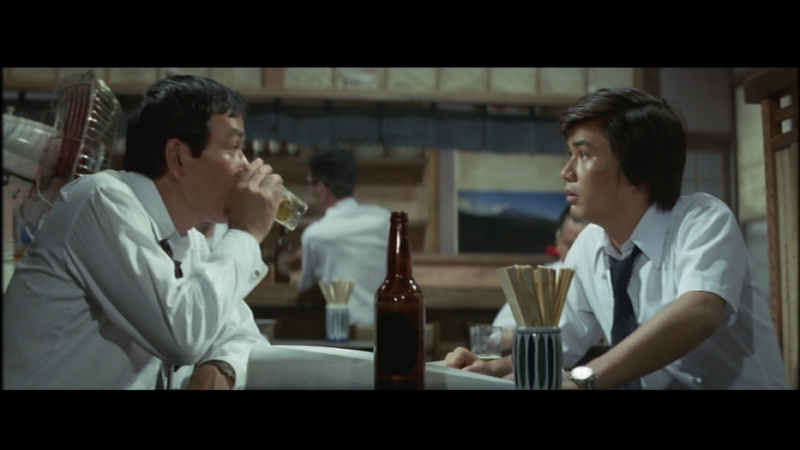 Both book and film deal with the same basic plot framework. A man is killed at the Kamata rail yard -- and police are not only unable to find the killer but even to identify the victim. Inspector Imanishi and a junior colleague Yoshimura make up two members of the police team assigned to this murder investigation -- and engage in a number of what seem to be wild goose chases (including a trip to Northern Honshu). When the victim's identity is discovered (a retired policeman from southern Honshu, who had run a small business for many years in),
Both book and film deal with the same basic plot framework. A man is killed at the Kamata rail yard -- and police are not only unable to find the killer but even to identify the victim. Inspector Imanishi and a junior colleague Yoshimura make up two members of the police team assigned to this murder investigation -- and engage in a number of what seem to be wild goose chases (including a trip to Northern Honshu). When the victim's identity is discovered (a retired policeman from southern Honshu, who had run a small business for many years in), 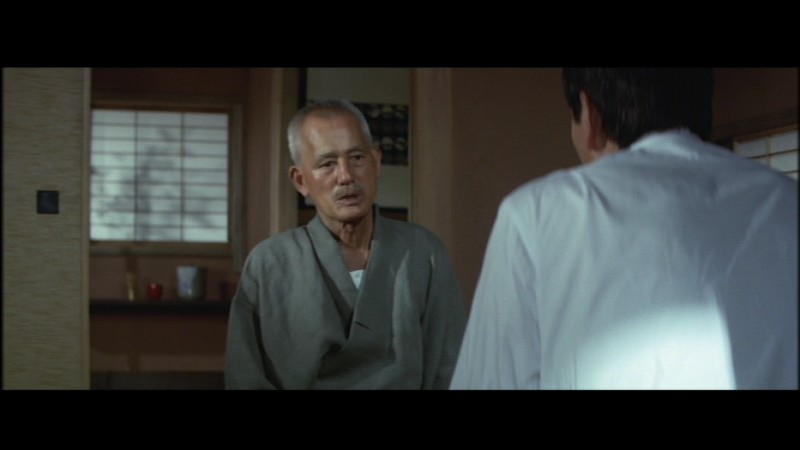 the mystery only deepens, as the man seemed to have led a virtually saintly existence, routinely doing good works despite his very limited resources. An independent thread of the story involves a group of bohemian artistic types. Yet another thread involves a leper and his son who the victim had helped out back in the late 30s, prior to his retirement from the police. Eventually both book and film connect these threads together.
the mystery only deepens, as the man seemed to have led a virtually saintly existence, routinely doing good works despite his very limited resources. An independent thread of the story involves a group of bohemian artistic types. Yet another thread involves a leper and his son who the victim had helped out back in the late 30s, prior to his retirement from the police. Eventually both book and film connect these threads together.
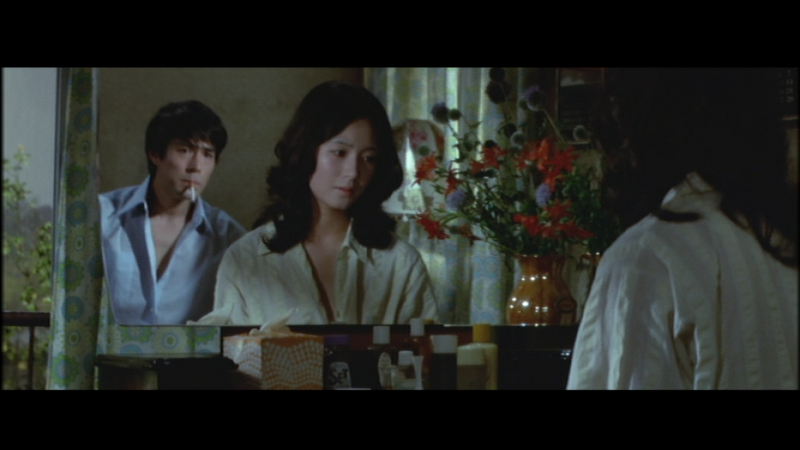 This is the fifth Nomura film I've seen and, despite its reputation, the least satisfactory. While Kage no kuruma had some significant stylistic problems, it also had a number of strengths (especially on the narrative level). Castle of Sand is even more problematic. Perhaps the most obvious problem, two key roles are poorly handled. Tetsuo Tamba hams it up as Imanishi, performing in a style at odds with the largely naturalistic performances of the rest of the cast.
This is the fifth Nomura film I've seen and, despite its reputation, the least satisfactory. While Kage no kuruma had some significant stylistic problems, it also had a number of strengths (especially on the narrative level). Castle of Sand is even more problematic. Perhaps the most obvious problem, two key roles are poorly handled. Tetsuo Tamba hams it up as Imanishi, performing in a style at odds with the largely naturalistic performances of the rest of the cast. 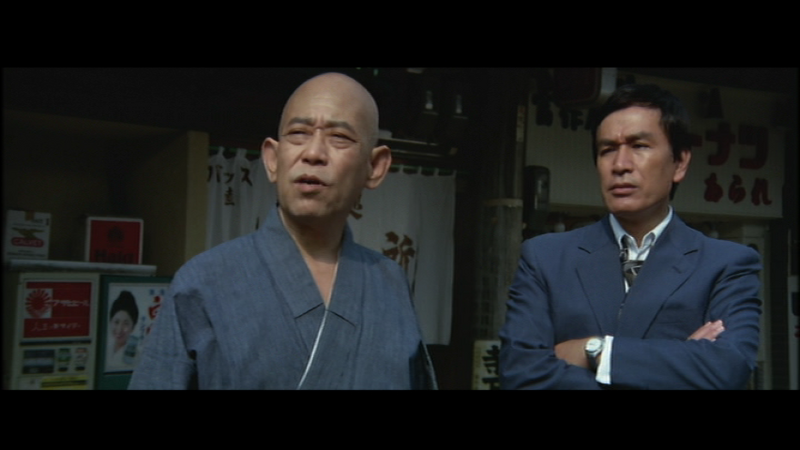 Less serious (but not trivial), the child actor who plays the leper's son was not very good here. Another serious problem, the structure of the film just didn't seem to make a lot of sense. The last third or so of the film is devoted to a picturesque (dialog-less) depiction of the wanderings of the leper and his son, as a noted pianist-composer plays and conducts his latest composition. Into this long sequence, Nomura scatters short bits of Imanishi presenting results of his investigations to the full investigative team. This extended section looks and sounds pretty, but seemed just a bit vacuous.
Less serious (but not trivial), the child actor who plays the leper's son was not very good here. Another serious problem, the structure of the film just didn't seem to make a lot of sense. The last third or so of the film is devoted to a picturesque (dialog-less) depiction of the wanderings of the leper and his son, as a noted pianist-composer plays and conducts his latest composition. Into this long sequence, Nomura scatters short bits of Imanishi presenting results of his investigations to the full investigative team. This extended section looks and sounds pretty, but seemed just a bit vacuous.
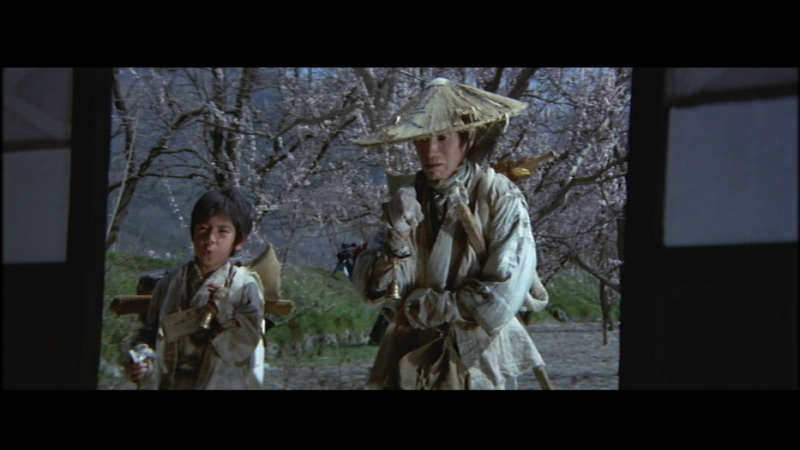 As it turns out, Matsumoto's novel spent comparatively little time on detailing the wanderings of the leper and his son. While the pair did play a significant role in the working out of the mystery, this aspect was handled mostly as a matter of background information. And what we are told of the wanderings of the two is at odds with the movie's treatment. In the book, the leper supposedly wandered from shrine to shrine, seeking miraculous healing; the film focuses on the two as mistreated outcasts, usually unable to even get charitable handouts. The book's focus is squarely on the process of investigation itself and the solving of the puzzles presented. Most of the narrative is focused on Imanishi, and no effort whatsoever is expended on trying to discern the "psychology" of the criminal.
As it turns out, Matsumoto's novel spent comparatively little time on detailing the wanderings of the leper and his son. While the pair did play a significant role in the working out of the mystery, this aspect was handled mostly as a matter of background information. And what we are told of the wanderings of the two is at odds with the movie's treatment. In the book, the leper supposedly wandered from shrine to shrine, seeking miraculous healing; the film focuses on the two as mistreated outcasts, usually unable to even get charitable handouts. The book's focus is squarely on the process of investigation itself and the solving of the puzzles presented. Most of the narrative is focused on Imanishi, and no effort whatsoever is expended on trying to discern the "psychology" of the criminal. 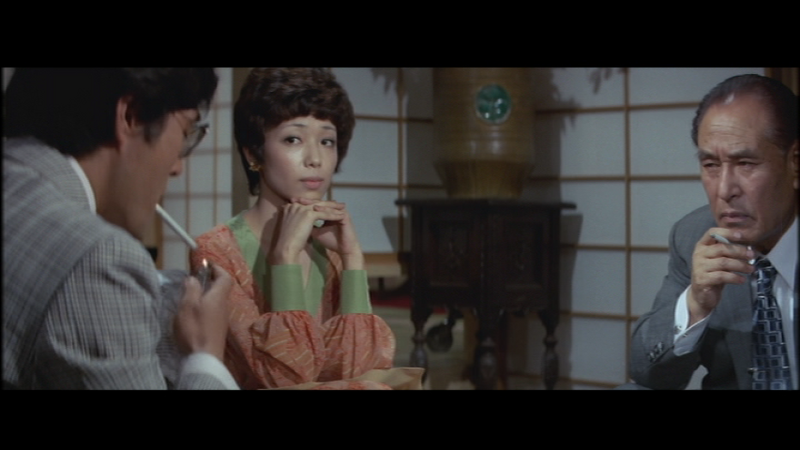 Insofar as the book has an important secondary focus, it deals with the group of fashionable (but a bit disreputable) artists. The film spends much less time of this part of the story -- and focuses solely on the musician, his fiancee and his girl friend. Somewhat incongruously, the avant-garde musician of the book (interested in electronics and "musique concrete") has become someone who writes rather conventional, neo-romantic concert music. Perhaps the most serious discrepancy between the book and the film -- the nature of Imanishi himself. Matsumoto's police detective is a far more interesting (yet far more restrained) individual than the blusterer presented by Tambo (and Nomura).
Insofar as the book has an important secondary focus, it deals with the group of fashionable (but a bit disreputable) artists. The film spends much less time of this part of the story -- and focuses solely on the musician, his fiancee and his girl friend. Somewhat incongruously, the avant-garde musician of the book (interested in electronics and "musique concrete") has become someone who writes rather conventional, neo-romantic concert music. Perhaps the most serious discrepancy between the book and the film -- the nature of Imanishi himself. Matsumoto's police detective is a far more interesting (yet far more restrained) individual than the blusterer presented by Tambo (and Nomura).
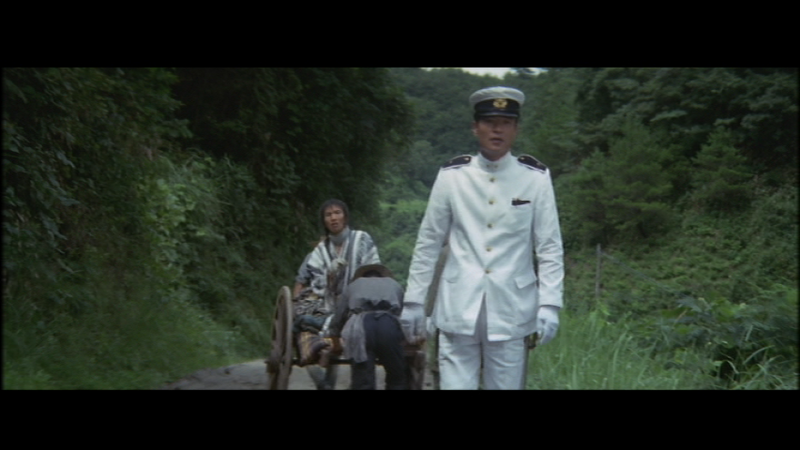 In watching the film, I found myself constantly trying to guess what Matsumoto's underlying story must have been. So many details rang false, that I was convinced that the film had to deviate seriously from the novel -- a feeling I never experienced while watching my four previous Nomura films (all based on Matsumoto's work). As it turns out, my hypothetical reconstruction of the story was largely confirmed when I got a copy of the novel from the Boston Public Library.
In watching the film, I found myself constantly trying to guess what Matsumoto's underlying story must have been. So many details rang false, that I was convinced that the film had to deviate seriously from the novel -- a feeling I never experienced while watching my four previous Nomura films (all based on Matsumoto's work). As it turns out, my hypothetical reconstruction of the story was largely confirmed when I got a copy of the novel from the Boston Public Library. 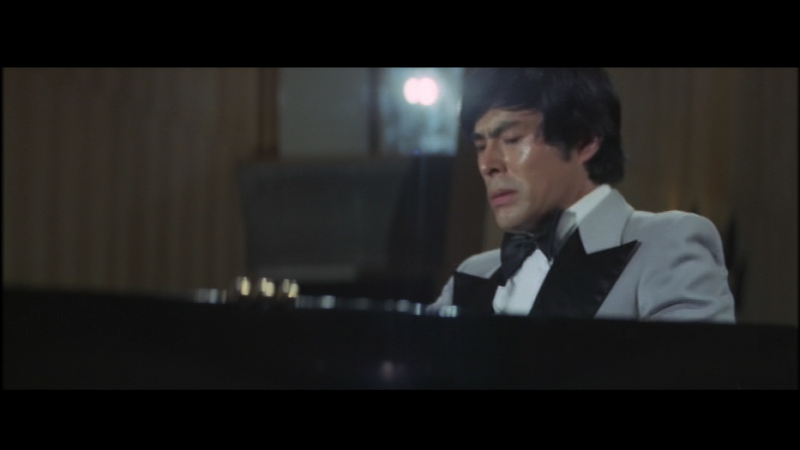 Perhaps the structure of the novel was too similar to Harikomi, perhaps the books heavy focus on puzzle solving (sometimes in delightfully nerdy detail -- especially on the issue of obscure regional dialects) was found too "undramatic" by Nomura and his screen writer (Shinobu Hashimoto). Another possible source of some of the film's problems -- when written in 1961, the book was tied to the era of the crime (and not too far removed from the pre-history of the crime). By the time the film was made, the early 60s seemed almost as remote (and subject to coating with a sort of nostalgic veneer) as the late 30s.
Perhaps the structure of the novel was too similar to Harikomi, perhaps the books heavy focus on puzzle solving (sometimes in delightfully nerdy detail -- especially on the issue of obscure regional dialects) was found too "undramatic" by Nomura and his screen writer (Shinobu Hashimoto). Another possible source of some of the film's problems -- when written in 1961, the book was tied to the era of the crime (and not too far removed from the pre-history of the crime). By the time the film was made, the early 60s seemed almost as remote (and subject to coating with a sort of nostalgic veneer) as the late 30s.
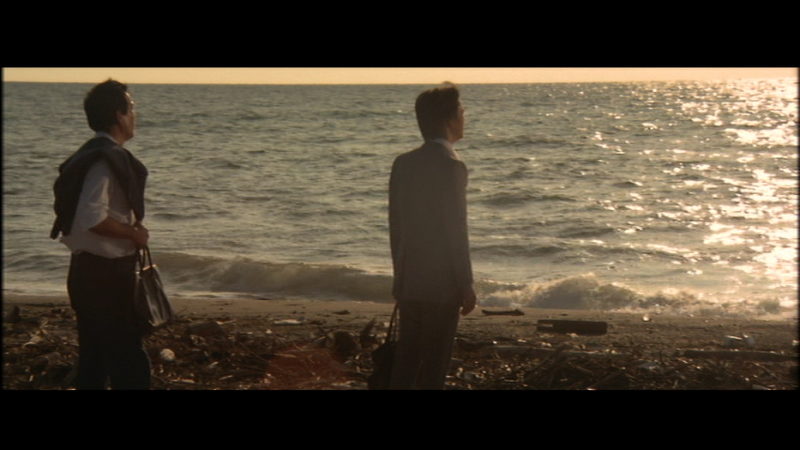 In terms of sheer visual pleasure, the Japanese DVD has to be seen as vastly superior to the subbed but mis-formatted (and rather low quality) Panorama DVD from Hong Kong. And, whatever serious flaws of both narrative structure and performance the film might have, it is full of lovely images.
In terms of sheer visual pleasure, the Japanese DVD has to be seen as vastly superior to the subbed but mis-formatted (and rather low quality) Panorama DVD from Hong Kong. And, whatever serious flaws of both narrative structure and performance the film might have, it is full of lovely images. 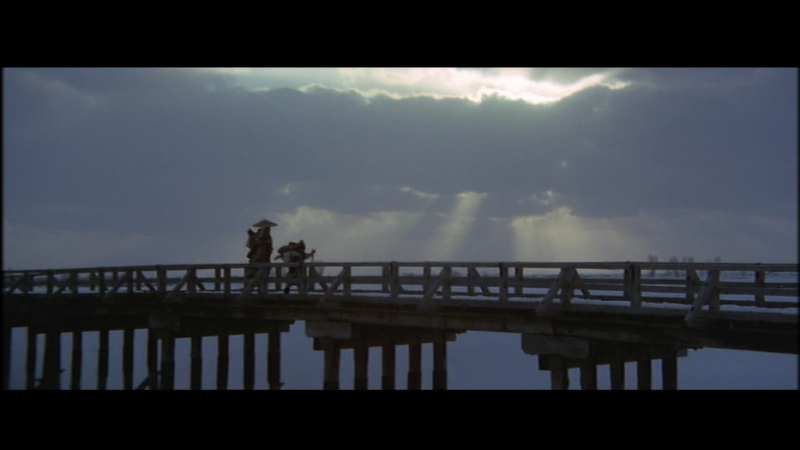 Despite my misgivings as to the film, I'd guess that a screening of a good-quality, properly formatted print might be worth attending. As to Matsumoto's book, I have almost no reservations -- anyone who is a fan of police procedurals with lots of local (and period) color is likely to enjoy the English translation, Inspector Imanishi Investigates.
Despite my misgivings as to the film, I'd guess that a screening of a good-quality, properly formatted print might be worth attending. As to Matsumoto's book, I have almost no reservations -- anyone who is a fan of police procedurals with lots of local (and period) color is likely to enjoy the English translation, Inspector Imanishi Investigates.
Tian xia wu zei / A World Without Thieves (FENG Xiaogang, 2004)
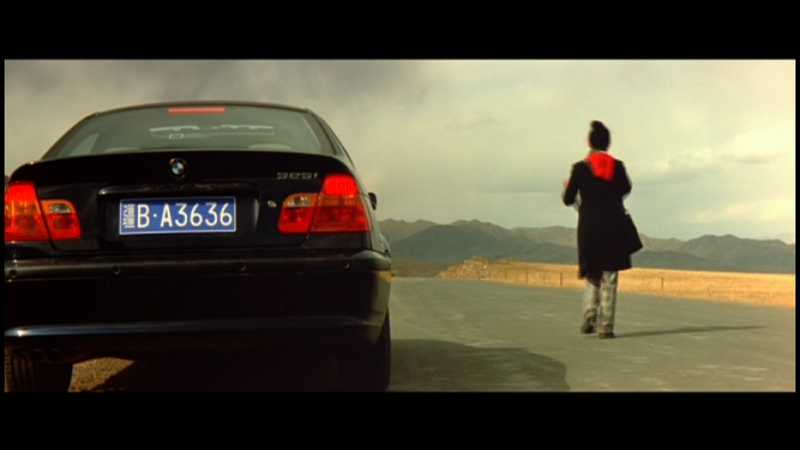 Feng has been one of mainland China's most successful directors -- in the domestic movie marketplace -- for quite some time. Although his recent, beautiful (but rather silly) historical film, The Banquet, was a disappointment, his previous film, World Without Thieves reminds one of just how good a "popular" film maker Feng is.
Feng has been one of mainland China's most successful directors -- in the domestic movie marketplace -- for quite some time. Although his recent, beautiful (but rather silly) historical film, The Banquet, was a disappointment, his previous film, World Without Thieves reminds one of just how good a "popular" film maker Feng is. 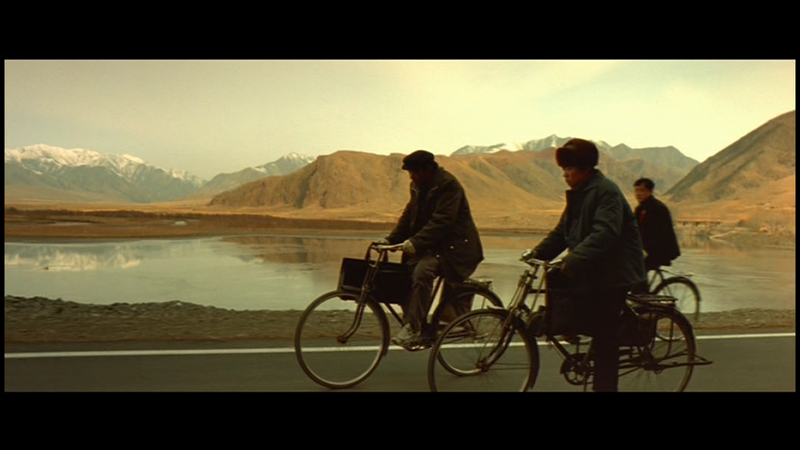 This film is, in some ways, calls to mind the work of HK film maker Johnnie To --particularly Yesterday Once More, which involved the same male lead (Andy Lau) and the same underlying situation (a pair of romantically-involved crooks, whose relationship is foundering). To's film, however, was released only two months before Feng's, so there would not seem to be any sort of copycat issue here.
This film is, in some ways, calls to mind the work of HK film maker Johnnie To --particularly Yesterday Once More, which involved the same male lead (Andy Lau) and the same underlying situation (a pair of romantically-involved crooks, whose relationship is foundering). To's film, however, was released only two months before Feng's, so there would not seem to be any sort of copycat issue here.
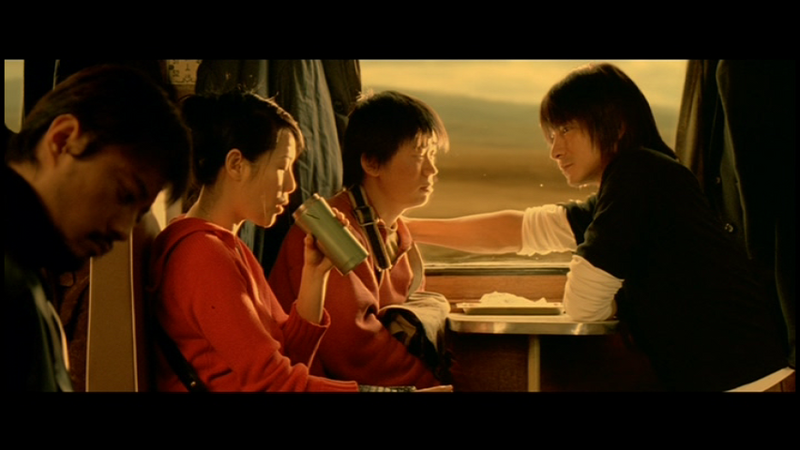 While To's criminal couple (Lau and Sammi Cheng) were top-flight jewel thieves, Feng's pair (Lau and Rene Liu) are pickpockets and confidence tricksters. For reasons not entirely clear, the two drive to Western China (in a car they extorted from a foolish businessman). During the course of the ride, after Lau uses a stop at a Buddhist shine to steal a multitude of cellphones while Liu fervently prays, the two split up. S
While To's criminal couple (Lau and Sammi Cheng) were top-flight jewel thieves, Feng's pair (Lau and Rene Liu) are pickpockets and confidence tricksters. For reasons not entirely clear, the two drive to Western China (in a car they extorted from a foolish businessman). During the course of the ride, after Lau uses a stop at a Buddhist shine to steal a multitude of cellphones while Liu fervently prays, the two split up. S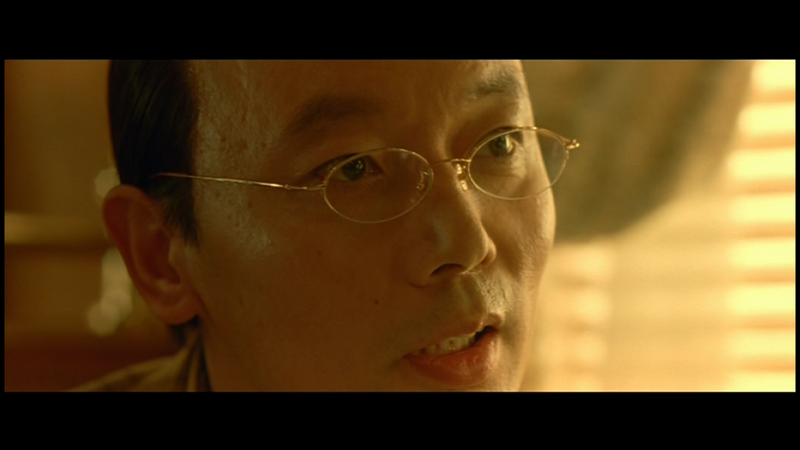 tranded (due to her own demand), Liu is "rescued" by a sweet-natured but very simple young shrine repairman (nicknamed Dumbo, played by WANG Boaqing) and his colleagues. Wang has decided to head home (foolishly taking his accumulated wages in cash -- against the advice of his more experienced co-workers). As fate would have it, Lau and Liu and Wang all wind up on the same train -- along with a criminal gang headed by GE You (a FENG regular) -- and some police detectives on vacation.
tranded (due to her own demand), Liu is "rescued" by a sweet-natured but very simple young shrine repairman (nicknamed Dumbo, played by WANG Boaqing) and his colleagues. Wang has decided to head home (foolishly taking his accumulated wages in cash -- against the advice of his more experienced co-workers). As fate would have it, Lau and Liu and Wang all wind up on the same train -- along with a criminal gang headed by GE You (a FENG regular) -- and some police detectives on vacation.
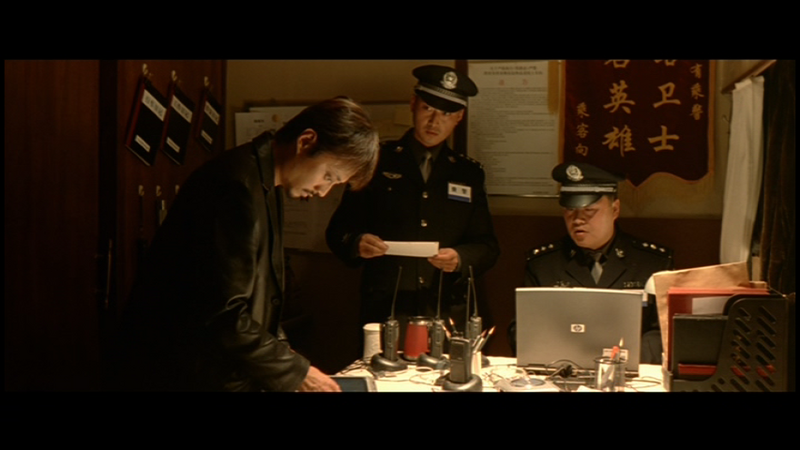 Wang, having rarely come across predatory humans, finds it impossible to believe that people are so dishonest and dangerous as his friends claimed. Thus, he (and his wad of cash) are at great risk during his train journey.
Wang, having rarely come across predatory humans, finds it impossible to believe that people are so dishonest and dangerous as his friends claimed. Thus, he (and his wad of cash) are at great risk during his train journey. 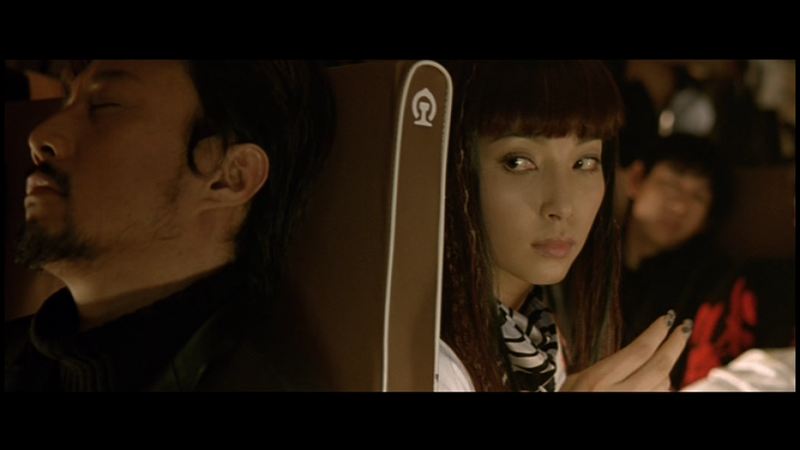 For a (sufficient) reason of her own, Liu decides to guard him and, to placate Liu, Lau sort of cooperates. Of course, by protecting Wang, Liu and Lau incur the enmity of Ge's gang (icluding the lovely but vicious LI Bingbing). Eventually, Lau and Ge negotiate a temporary truce -- but as the train approaches its destination things get more and more complicated.
For a (sufficient) reason of her own, Liu decides to guard him and, to placate Liu, Lau sort of cooperates. Of course, by protecting Wang, Liu and Lau incur the enmity of Ge's gang (icluding the lovely but vicious LI Bingbing). Eventually, Lau and Ge negotiate a temporary truce -- but as the train approaches its destination things get more and more complicated.
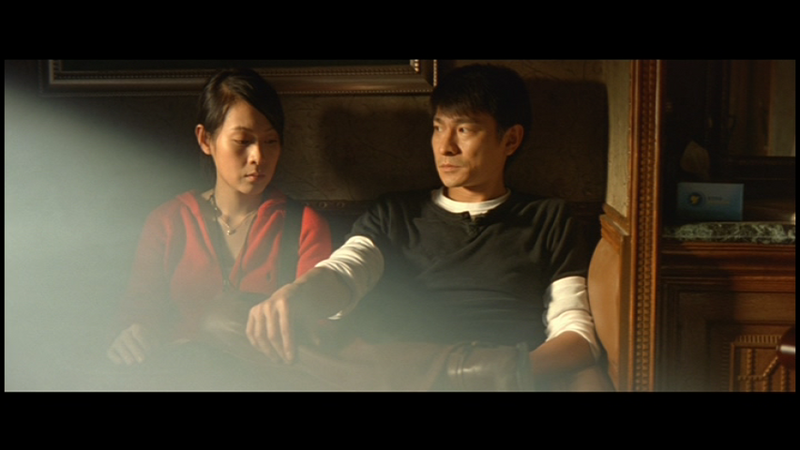 Like To's 2003 Running on Karma and Ann Hui's Goddess of Mercy of the same year, this film has a distinctly religious tinge. Buddhist concepts are close to the core of all these films. The combination of religion, action-adventure and romantic comedy seems a bit unwieldy (given Western expectations) but works quite well overall here. The premise of the story is a bit farfetched, but the performances and the cinematography (by ZHANG Li) successfully carry this along.
Like To's 2003 Running on Karma and Ann Hui's Goddess of Mercy of the same year, this film has a distinctly religious tinge. Buddhist concepts are close to the core of all these films. The combination of religion, action-adventure and romantic comedy seems a bit unwieldy (given Western expectations) but works quite well overall here. The premise of the story is a bit farfetched, but the performances and the cinematography (by ZHANG Li) successfully carry this along.
Kong que / Peacock (GU Changwei, 2005)
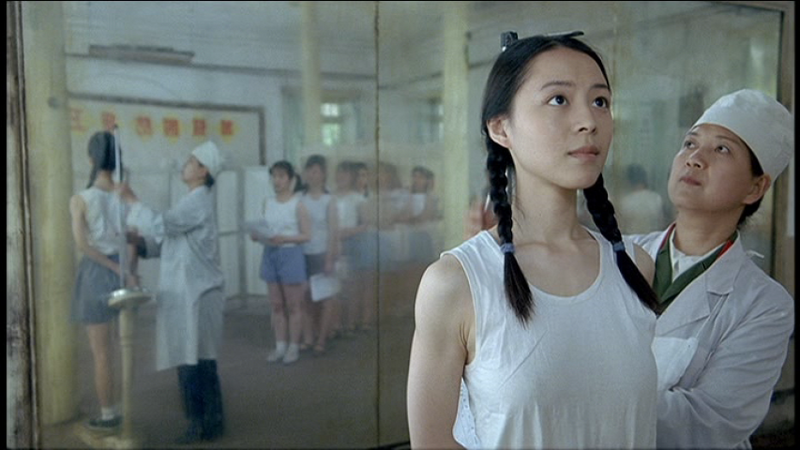 Gu is one of China's finest cinematographers, having done excellent work with ZHANG Yimou, CHEN Kaige and JIANG Wen. Peacock is the first film he has directed -- and (not surprisingly) one of its strongest features is its cinematography (by YANG Shu). In terms of "narrative", the film is rather hard to assess.
Gu is one of China's finest cinematographers, having done excellent work with ZHANG Yimou, CHEN Kaige and JIANG Wen. Peacock is the first film he has directed -- and (not surprisingly) one of its strongest features is its cinematography (by YANG Shu). In terms of "narrative", the film is rather hard to assess. 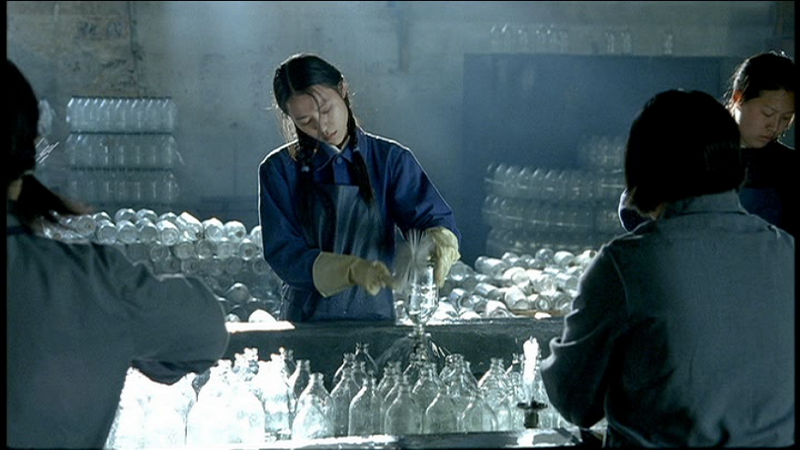 The film presents its story from the perspectives on each of three characters: the late teen-aged daughter (ZHANG Jingchu) of a working class family in a provincial town, her massively obese, mentally challenged, spoiled older brother (FENG Li) and her repressed and rather resentful younger brother (LU Yulai).
The film presents its story from the perspectives on each of three characters: the late teen-aged daughter (ZHANG Jingchu) of a working class family in a provincial town, her massively obese, mentally challenged, spoiled older brother (FENG Li) and her repressed and rather resentful younger brother (LU Yulai). 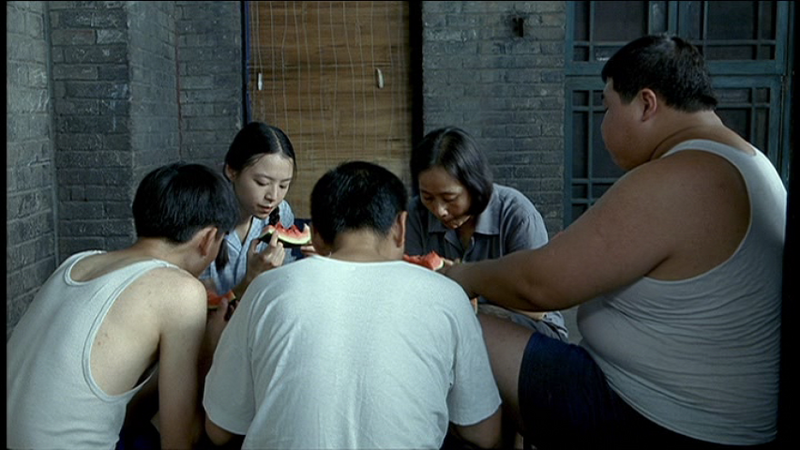 Originally, the film was 240 minutes long -- and one assumes that around 80 minutes were allotted to each of the three parts. As released, however, the film was massively cut down -- to a mere 14o minutes. Around 60 minutes are allotted to the daughter's story, around 50 to the older brother's and only about 30 to the younger brother's. While the first two sections of the film seem, perhaps, a bit elliptical -- the last comes across as rather fragmentary and chaotic.
Originally, the film was 240 minutes long -- and one assumes that around 80 minutes were allotted to each of the three parts. As released, however, the film was massively cut down -- to a mere 14o minutes. Around 60 minutes are allotted to the daughter's story, around 50 to the older brother's and only about 30 to the younger brother's. While the first two sections of the film seem, perhaps, a bit elliptical -- the last comes across as rather fragmentary and chaotic.
 None of the children in the "ordinary" family in provinvial China of the late 1970s and early 1980s is a model citizen. The daughter is an indifferent worker -- but she has dreams. She falls in love with an army paratrooper she encounters by chance -- and wants to join the reserve parachuting squad, but discovers her idol isn't particularly interested in her. S
None of the children in the "ordinary" family in provinvial China of the late 1970s and early 1980s is a model citizen. The daughter is an indifferent worker -- but she has dreams. She falls in love with an army paratrooper she encounters by chance -- and wants to join the reserve parachuting squad, but discovers her idol isn't particularly interested in her. S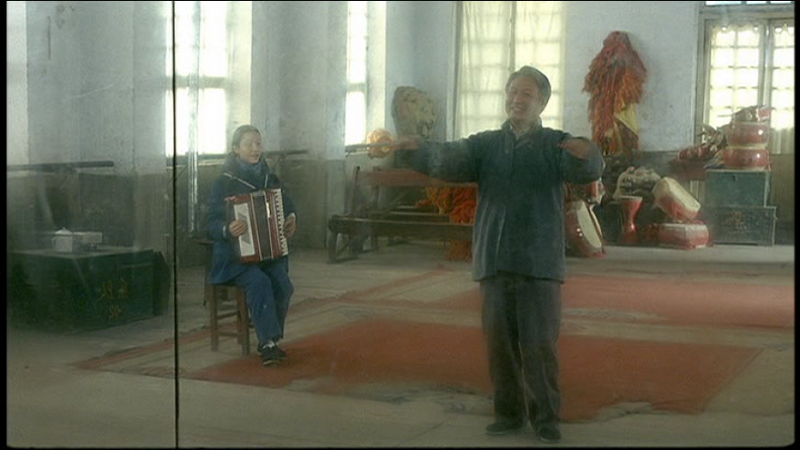 he gets involved with a local "bad boy" and into yet more trouble because of her fondness for a middle-aged accordion teacher. Ultimately, fed up with her family, she escapes rather cold-bloodedly into a marriage of convenience with an older man (who is neither charming nor handsome). The older brother is even more disastrous in work settings than his sister -- and he is coddled in his laziness and greediness by his mother. A
he gets involved with a local "bad boy" and into yet more trouble because of her fondness for a middle-aged accordion teacher. Ultimately, fed up with her family, she escapes rather cold-bloodedly into a marriage of convenience with an older man (who is neither charming nor handsome). The older brother is even more disastrous in work settings than his sister -- and he is coddled in his laziness and greediness by his mother. A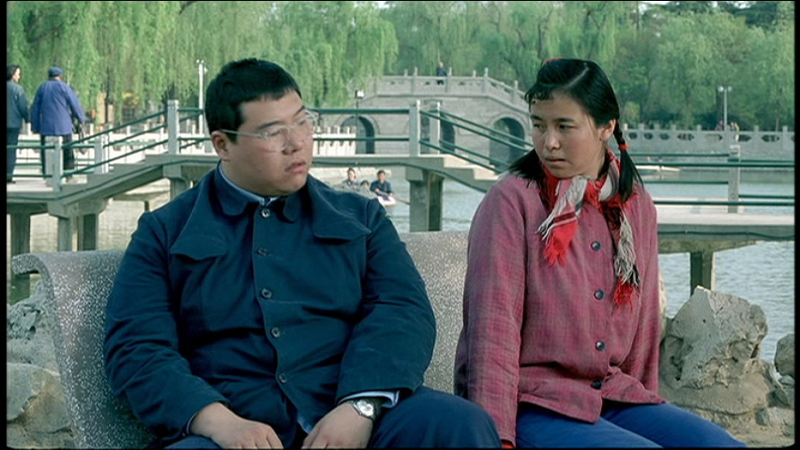 fter his attempt at courting a pretty local girl falls flat, his mother arranges a marriage with a country girl with a bad leg (thus making her unsuitable as a farm wife). The two eventually open a food stall -- and seem to do reasonably well. The younger brother is driven to distraction by his brother. His father seems to sympathize with his plight, but explodes with anger on finding a "dirty"drawing in the son's notebook. Kicked out of the house, the son disappears for years -- only to return with a somewhat dodgy spouse and a young baby.
fter his attempt at courting a pretty local girl falls flat, his mother arranges a marriage with a country girl with a bad leg (thus making her unsuitable as a farm wife). The two eventually open a food stall -- and seem to do reasonably well. The younger brother is driven to distraction by his brother. His father seems to sympathize with his plight, but explodes with anger on finding a "dirty"drawing in the son's notebook. Kicked out of the house, the son disappears for years -- only to return with a somewhat dodgy spouse and a young baby.
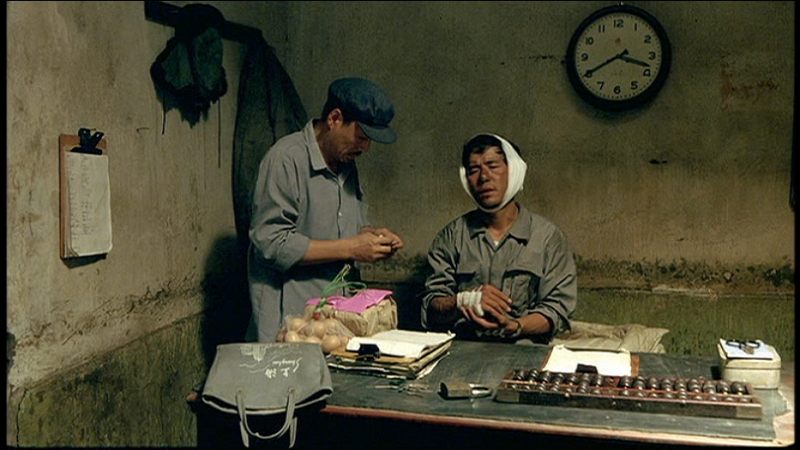 The first segment of the film can almost stand as a film in its own right (and, with 20 minutes added back in, would probably do so). Zhang is a wonderful actress -- and captures her character's blend of surliness, dreaminess and desperation almost perfectly. It is a bit hard to judge Feng's performance as the older brother -- as his character is so extreme in both appearance and behavior.
The first segment of the film can almost stand as a film in its own right (and, with 20 minutes added back in, would probably do so). Zhang is a wonderful actress -- and captures her character's blend of surliness, dreaminess and desperation almost perfectly. It is a bit hard to judge Feng's performance as the older brother -- as his character is so extreme in both appearance and behavior. 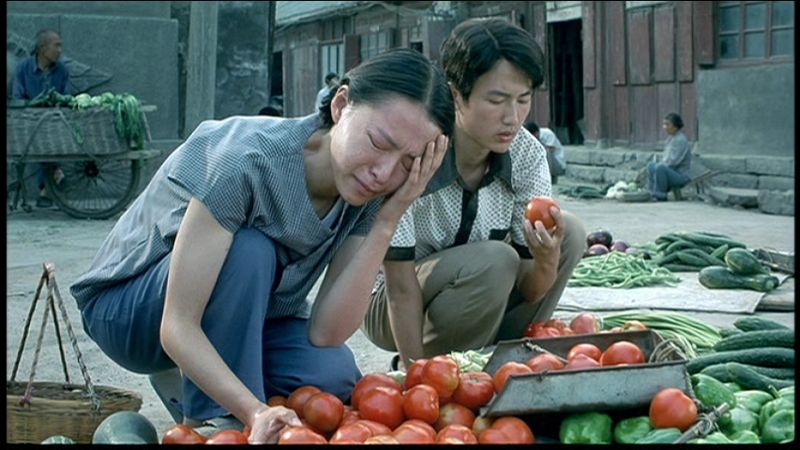 Moreover, his segment was not as intriguing as that of his sister, but once the rural would-be bride arrived, things improved. It is even harder to judge Lu's younger brother as the segment in which he is featured is so abbreviated -- and we get relatively little idea of what his character is like. Pending availability of a more complete version, I'd judge the current version of Peacock well worth seeing on account of Zhang's performance and the cinematography.
Moreover, his segment was not as intriguing as that of his sister, but once the rural would-be bride arrived, things improved. It is even harder to judge Lu's younger brother as the segment in which he is featured is so abbreviated -- and we get relatively little idea of what his character is like. Pending availability of a more complete version, I'd judge the current version of Peacock well worth seeing on account of Zhang's performance and the cinematography.
More screen shots:
http://i9.photobucket.com/albums/a59/mkerpan/sept_07/peacock02.png
http://i9.photobucket.com/albums/a59/mkerpan/sept_07/peacock03.png
http://i9.photobucket.com/albums/a59/mkerpan/sept_07/peacock04.png
http://i9.photobucket.com/albums/a59/mkerpan/sept_07/peacock06.png
http://i9.photobucket.com/albums/a59/mkerpan/sept_07/peacock10.png
http://i9.photobucket.com/albums/a59/mkerpan/sept_07/peacock13.png
http://i9.photobucket.com/albums/a59/mkerpan/sept_07/peacock14.png
Suna no utsuwa / The Castle of Sand (Yoshitaro Nomura, 1974)
 The title of both book (1961) and movie (1974) is literally translated as "bowl made of sand", the notion being something created with great care that is extremely transient in nature. Matsumoto , the author of the book on which many of Nomura's films were based (including this one) is generally considered one of the greatest Japanese writers of mysteries and crime fiction. Despite his domestic fame, very little of his work (other than Suna no utsuwa is available in English.
The title of both book (1961) and movie (1974) is literally translated as "bowl made of sand", the notion being something created with great care that is extremely transient in nature. Matsumoto , the author of the book on which many of Nomura's films were based (including this one) is generally considered one of the greatest Japanese writers of mysteries and crime fiction. Despite his domestic fame, very little of his work (other than Suna no utsuwa is available in English.  Both book and film deal with the same basic plot framework. A man is killed at the Kamata rail yard -- and police are not only unable to find the killer but even to identify the victim. Inspector Imanishi and a junior colleague Yoshimura make up two members of the police team assigned to this murder investigation -- and engage in a number of what seem to be wild goose chases (including a trip to Northern Honshu). When the victim's identity is discovered (a retired policeman from southern Honshu, who had run a small business for many years in),
Both book and film deal with the same basic plot framework. A man is killed at the Kamata rail yard -- and police are not only unable to find the killer but even to identify the victim. Inspector Imanishi and a junior colleague Yoshimura make up two members of the police team assigned to this murder investigation -- and engage in a number of what seem to be wild goose chases (including a trip to Northern Honshu). When the victim's identity is discovered (a retired policeman from southern Honshu, who had run a small business for many years in),  the mystery only deepens, as the man seemed to have led a virtually saintly existence, routinely doing good works despite his very limited resources. An independent thread of the story involves a group of bohemian artistic types. Yet another thread involves a leper and his son who the victim had helped out back in the late 30s, prior to his retirement from the police. Eventually both book and film connect these threads together.
the mystery only deepens, as the man seemed to have led a virtually saintly existence, routinely doing good works despite his very limited resources. An independent thread of the story involves a group of bohemian artistic types. Yet another thread involves a leper and his son who the victim had helped out back in the late 30s, prior to his retirement from the police. Eventually both book and film connect these threads together. This is the fifth Nomura film I've seen and, despite its reputation, the least satisfactory. While Kage no kuruma had some significant stylistic problems, it also had a number of strengths (especially on the narrative level). Castle of Sand is even more problematic. Perhaps the most obvious problem, two key roles are poorly handled. Tetsuo Tamba hams it up as Imanishi, performing in a style at odds with the largely naturalistic performances of the rest of the cast.
This is the fifth Nomura film I've seen and, despite its reputation, the least satisfactory. While Kage no kuruma had some significant stylistic problems, it also had a number of strengths (especially on the narrative level). Castle of Sand is even more problematic. Perhaps the most obvious problem, two key roles are poorly handled. Tetsuo Tamba hams it up as Imanishi, performing in a style at odds with the largely naturalistic performances of the rest of the cast.  Less serious (but not trivial), the child actor who plays the leper's son was not very good here. Another serious problem, the structure of the film just didn't seem to make a lot of sense. The last third or so of the film is devoted to a picturesque (dialog-less) depiction of the wanderings of the leper and his son, as a noted pianist-composer plays and conducts his latest composition. Into this long sequence, Nomura scatters short bits of Imanishi presenting results of his investigations to the full investigative team. This extended section looks and sounds pretty, but seemed just a bit vacuous.
Less serious (but not trivial), the child actor who plays the leper's son was not very good here. Another serious problem, the structure of the film just didn't seem to make a lot of sense. The last third or so of the film is devoted to a picturesque (dialog-less) depiction of the wanderings of the leper and his son, as a noted pianist-composer plays and conducts his latest composition. Into this long sequence, Nomura scatters short bits of Imanishi presenting results of his investigations to the full investigative team. This extended section looks and sounds pretty, but seemed just a bit vacuous. As it turns out, Matsumoto's novel spent comparatively little time on detailing the wanderings of the leper and his son. While the pair did play a significant role in the working out of the mystery, this aspect was handled mostly as a matter of background information. And what we are told of the wanderings of the two is at odds with the movie's treatment. In the book, the leper supposedly wandered from shrine to shrine, seeking miraculous healing; the film focuses on the two as mistreated outcasts, usually unable to even get charitable handouts. The book's focus is squarely on the process of investigation itself and the solving of the puzzles presented. Most of the narrative is focused on Imanishi, and no effort whatsoever is expended on trying to discern the "psychology" of the criminal.
As it turns out, Matsumoto's novel spent comparatively little time on detailing the wanderings of the leper and his son. While the pair did play a significant role in the working out of the mystery, this aspect was handled mostly as a matter of background information. And what we are told of the wanderings of the two is at odds with the movie's treatment. In the book, the leper supposedly wandered from shrine to shrine, seeking miraculous healing; the film focuses on the two as mistreated outcasts, usually unable to even get charitable handouts. The book's focus is squarely on the process of investigation itself and the solving of the puzzles presented. Most of the narrative is focused on Imanishi, and no effort whatsoever is expended on trying to discern the "psychology" of the criminal.  Insofar as the book has an important secondary focus, it deals with the group of fashionable (but a bit disreputable) artists. The film spends much less time of this part of the story -- and focuses solely on the musician, his fiancee and his girl friend. Somewhat incongruously, the avant-garde musician of the book (interested in electronics and "musique concrete") has become someone who writes rather conventional, neo-romantic concert music. Perhaps the most serious discrepancy between the book and the film -- the nature of Imanishi himself. Matsumoto's police detective is a far more interesting (yet far more restrained) individual than the blusterer presented by Tambo (and Nomura).
Insofar as the book has an important secondary focus, it deals with the group of fashionable (but a bit disreputable) artists. The film spends much less time of this part of the story -- and focuses solely on the musician, his fiancee and his girl friend. Somewhat incongruously, the avant-garde musician of the book (interested in electronics and "musique concrete") has become someone who writes rather conventional, neo-romantic concert music. Perhaps the most serious discrepancy between the book and the film -- the nature of Imanishi himself. Matsumoto's police detective is a far more interesting (yet far more restrained) individual than the blusterer presented by Tambo (and Nomura). In watching the film, I found myself constantly trying to guess what Matsumoto's underlying story must have been. So many details rang false, that I was convinced that the film had to deviate seriously from the novel -- a feeling I never experienced while watching my four previous Nomura films (all based on Matsumoto's work). As it turns out, my hypothetical reconstruction of the story was largely confirmed when I got a copy of the novel from the Boston Public Library.
In watching the film, I found myself constantly trying to guess what Matsumoto's underlying story must have been. So many details rang false, that I was convinced that the film had to deviate seriously from the novel -- a feeling I never experienced while watching my four previous Nomura films (all based on Matsumoto's work). As it turns out, my hypothetical reconstruction of the story was largely confirmed when I got a copy of the novel from the Boston Public Library.  Perhaps the structure of the novel was too similar to Harikomi, perhaps the books heavy focus on puzzle solving (sometimes in delightfully nerdy detail -- especially on the issue of obscure regional dialects) was found too "undramatic" by Nomura and his screen writer (Shinobu Hashimoto). Another possible source of some of the film's problems -- when written in 1961, the book was tied to the era of the crime (and not too far removed from the pre-history of the crime). By the time the film was made, the early 60s seemed almost as remote (and subject to coating with a sort of nostalgic veneer) as the late 30s.
Perhaps the structure of the novel was too similar to Harikomi, perhaps the books heavy focus on puzzle solving (sometimes in delightfully nerdy detail -- especially on the issue of obscure regional dialects) was found too "undramatic" by Nomura and his screen writer (Shinobu Hashimoto). Another possible source of some of the film's problems -- when written in 1961, the book was tied to the era of the crime (and not too far removed from the pre-history of the crime). By the time the film was made, the early 60s seemed almost as remote (and subject to coating with a sort of nostalgic veneer) as the late 30s. In terms of sheer visual pleasure, the Japanese DVD has to be seen as vastly superior to the subbed but mis-formatted (and rather low quality) Panorama DVD from Hong Kong. And, whatever serious flaws of both narrative structure and performance the film might have, it is full of lovely images.
In terms of sheer visual pleasure, the Japanese DVD has to be seen as vastly superior to the subbed but mis-formatted (and rather low quality) Panorama DVD from Hong Kong. And, whatever serious flaws of both narrative structure and performance the film might have, it is full of lovely images.  Despite my misgivings as to the film, I'd guess that a screening of a good-quality, properly formatted print might be worth attending. As to Matsumoto's book, I have almost no reservations -- anyone who is a fan of police procedurals with lots of local (and period) color is likely to enjoy the English translation, Inspector Imanishi Investigates.
Despite my misgivings as to the film, I'd guess that a screening of a good-quality, properly formatted print might be worth attending. As to Matsumoto's book, I have almost no reservations -- anyone who is a fan of police procedurals with lots of local (and period) color is likely to enjoy the English translation, Inspector Imanishi Investigates.Tian xia wu zei / A World Without Thieves (FENG Xiaogang, 2004)
 Feng has been one of mainland China's most successful directors -- in the domestic movie marketplace -- for quite some time. Although his recent, beautiful (but rather silly) historical film, The Banquet, was a disappointment, his previous film, World Without Thieves reminds one of just how good a "popular" film maker Feng is.
Feng has been one of mainland China's most successful directors -- in the domestic movie marketplace -- for quite some time. Although his recent, beautiful (but rather silly) historical film, The Banquet, was a disappointment, his previous film, World Without Thieves reminds one of just how good a "popular" film maker Feng is.  This film is, in some ways, calls to mind the work of HK film maker Johnnie To --particularly Yesterday Once More, which involved the same male lead (Andy Lau) and the same underlying situation (a pair of romantically-involved crooks, whose relationship is foundering). To's film, however, was released only two months before Feng's, so there would not seem to be any sort of copycat issue here.
This film is, in some ways, calls to mind the work of HK film maker Johnnie To --particularly Yesterday Once More, which involved the same male lead (Andy Lau) and the same underlying situation (a pair of romantically-involved crooks, whose relationship is foundering). To's film, however, was released only two months before Feng's, so there would not seem to be any sort of copycat issue here. While To's criminal couple (Lau and Sammi Cheng) were top-flight jewel thieves, Feng's pair (Lau and Rene Liu) are pickpockets and confidence tricksters. For reasons not entirely clear, the two drive to Western China (in a car they extorted from a foolish businessman). During the course of the ride, after Lau uses a stop at a Buddhist shine to steal a multitude of cellphones while Liu fervently prays, the two split up. S
While To's criminal couple (Lau and Sammi Cheng) were top-flight jewel thieves, Feng's pair (Lau and Rene Liu) are pickpockets and confidence tricksters. For reasons not entirely clear, the two drive to Western China (in a car they extorted from a foolish businessman). During the course of the ride, after Lau uses a stop at a Buddhist shine to steal a multitude of cellphones while Liu fervently prays, the two split up. S tranded (due to her own demand), Liu is "rescued" by a sweet-natured but very simple young shrine repairman (nicknamed Dumbo, played by WANG Boaqing) and his colleagues. Wang has decided to head home (foolishly taking his accumulated wages in cash -- against the advice of his more experienced co-workers). As fate would have it, Lau and Liu and Wang all wind up on the same train -- along with a criminal gang headed by GE You (a FENG regular) -- and some police detectives on vacation.
tranded (due to her own demand), Liu is "rescued" by a sweet-natured but very simple young shrine repairman (nicknamed Dumbo, played by WANG Boaqing) and his colleagues. Wang has decided to head home (foolishly taking his accumulated wages in cash -- against the advice of his more experienced co-workers). As fate would have it, Lau and Liu and Wang all wind up on the same train -- along with a criminal gang headed by GE You (a FENG regular) -- and some police detectives on vacation. Wang, having rarely come across predatory humans, finds it impossible to believe that people are so dishonest and dangerous as his friends claimed. Thus, he (and his wad of cash) are at great risk during his train journey.
Wang, having rarely come across predatory humans, finds it impossible to believe that people are so dishonest and dangerous as his friends claimed. Thus, he (and his wad of cash) are at great risk during his train journey.  For a (sufficient) reason of her own, Liu decides to guard him and, to placate Liu, Lau sort of cooperates. Of course, by protecting Wang, Liu and Lau incur the enmity of Ge's gang (icluding the lovely but vicious LI Bingbing). Eventually, Lau and Ge negotiate a temporary truce -- but as the train approaches its destination things get more and more complicated.
For a (sufficient) reason of her own, Liu decides to guard him and, to placate Liu, Lau sort of cooperates. Of course, by protecting Wang, Liu and Lau incur the enmity of Ge's gang (icluding the lovely but vicious LI Bingbing). Eventually, Lau and Ge negotiate a temporary truce -- but as the train approaches its destination things get more and more complicated. Like To's 2003 Running on Karma and Ann Hui's Goddess of Mercy of the same year, this film has a distinctly religious tinge. Buddhist concepts are close to the core of all these films. The combination of religion, action-adventure and romantic comedy seems a bit unwieldy (given Western expectations) but works quite well overall here. The premise of the story is a bit farfetched, but the performances and the cinematography (by ZHANG Li) successfully carry this along.
Like To's 2003 Running on Karma and Ann Hui's Goddess of Mercy of the same year, this film has a distinctly religious tinge. Buddhist concepts are close to the core of all these films. The combination of religion, action-adventure and romantic comedy seems a bit unwieldy (given Western expectations) but works quite well overall here. The premise of the story is a bit farfetched, but the performances and the cinematography (by ZHANG Li) successfully carry this along.Kong que / Peacock (GU Changwei, 2005)
 Gu is one of China's finest cinematographers, having done excellent work with ZHANG Yimou, CHEN Kaige and JIANG Wen. Peacock is the first film he has directed -- and (not surprisingly) one of its strongest features is its cinematography (by YANG Shu). In terms of "narrative", the film is rather hard to assess.
Gu is one of China's finest cinematographers, having done excellent work with ZHANG Yimou, CHEN Kaige and JIANG Wen. Peacock is the first film he has directed -- and (not surprisingly) one of its strongest features is its cinematography (by YANG Shu). In terms of "narrative", the film is rather hard to assess.  The film presents its story from the perspectives on each of three characters: the late teen-aged daughter (ZHANG Jingchu) of a working class family in a provincial town, her massively obese, mentally challenged, spoiled older brother (FENG Li) and her repressed and rather resentful younger brother (LU Yulai).
The film presents its story from the perspectives on each of three characters: the late teen-aged daughter (ZHANG Jingchu) of a working class family in a provincial town, her massively obese, mentally challenged, spoiled older brother (FENG Li) and her repressed and rather resentful younger brother (LU Yulai).  Originally, the film was 240 minutes long -- and one assumes that around 80 minutes were allotted to each of the three parts. As released, however, the film was massively cut down -- to a mere 14o minutes. Around 60 minutes are allotted to the daughter's story, around 50 to the older brother's and only about 30 to the younger brother's. While the first two sections of the film seem, perhaps, a bit elliptical -- the last comes across as rather fragmentary and chaotic.
Originally, the film was 240 minutes long -- and one assumes that around 80 minutes were allotted to each of the three parts. As released, however, the film was massively cut down -- to a mere 14o minutes. Around 60 minutes are allotted to the daughter's story, around 50 to the older brother's and only about 30 to the younger brother's. While the first two sections of the film seem, perhaps, a bit elliptical -- the last comes across as rather fragmentary and chaotic. None of the children in the "ordinary" family in provinvial China of the late 1970s and early 1980s is a model citizen. The daughter is an indifferent worker -- but she has dreams. She falls in love with an army paratrooper she encounters by chance -- and wants to join the reserve parachuting squad, but discovers her idol isn't particularly interested in her. S
None of the children in the "ordinary" family in provinvial China of the late 1970s and early 1980s is a model citizen. The daughter is an indifferent worker -- but she has dreams. She falls in love with an army paratrooper she encounters by chance -- and wants to join the reserve parachuting squad, but discovers her idol isn't particularly interested in her. S he gets involved with a local "bad boy" and into yet more trouble because of her fondness for a middle-aged accordion teacher. Ultimately, fed up with her family, she escapes rather cold-bloodedly into a marriage of convenience with an older man (who is neither charming nor handsome). The older brother is even more disastrous in work settings than his sister -- and he is coddled in his laziness and greediness by his mother. A
he gets involved with a local "bad boy" and into yet more trouble because of her fondness for a middle-aged accordion teacher. Ultimately, fed up with her family, she escapes rather cold-bloodedly into a marriage of convenience with an older man (who is neither charming nor handsome). The older brother is even more disastrous in work settings than his sister -- and he is coddled in his laziness and greediness by his mother. A fter his attempt at courting a pretty local girl falls flat, his mother arranges a marriage with a country girl with a bad leg (thus making her unsuitable as a farm wife). The two eventually open a food stall -- and seem to do reasonably well. The younger brother is driven to distraction by his brother. His father seems to sympathize with his plight, but explodes with anger on finding a "dirty"drawing in the son's notebook. Kicked out of the house, the son disappears for years -- only to return with a somewhat dodgy spouse and a young baby.
fter his attempt at courting a pretty local girl falls flat, his mother arranges a marriage with a country girl with a bad leg (thus making her unsuitable as a farm wife). The two eventually open a food stall -- and seem to do reasonably well. The younger brother is driven to distraction by his brother. His father seems to sympathize with his plight, but explodes with anger on finding a "dirty"drawing in the son's notebook. Kicked out of the house, the son disappears for years -- only to return with a somewhat dodgy spouse and a young baby. The first segment of the film can almost stand as a film in its own right (and, with 20 minutes added back in, would probably do so). Zhang is a wonderful actress -- and captures her character's blend of surliness, dreaminess and desperation almost perfectly. It is a bit hard to judge Feng's performance as the older brother -- as his character is so extreme in both appearance and behavior.
The first segment of the film can almost stand as a film in its own right (and, with 20 minutes added back in, would probably do so). Zhang is a wonderful actress -- and captures her character's blend of surliness, dreaminess and desperation almost perfectly. It is a bit hard to judge Feng's performance as the older brother -- as his character is so extreme in both appearance and behavior.  Moreover, his segment was not as intriguing as that of his sister, but once the rural would-be bride arrived, things improved. It is even harder to judge Lu's younger brother as the segment in which he is featured is so abbreviated -- and we get relatively little idea of what his character is like. Pending availability of a more complete version, I'd judge the current version of Peacock well worth seeing on account of Zhang's performance and the cinematography.
Moreover, his segment was not as intriguing as that of his sister, but once the rural would-be bride arrived, things improved. It is even harder to judge Lu's younger brother as the segment in which he is featured is so abbreviated -- and we get relatively little idea of what his character is like. Pending availability of a more complete version, I'd judge the current version of Peacock well worth seeing on account of Zhang's performance and the cinematography.More screen shots:
http://i9.photobucket.com/albums/a59/mkerpan/sept_07/peacock02.png
http://i9.photobucket.com/albums/a59/mkerpan/sept_07/peacock03.png
http://i9.photobucket.com/albums/a59/mkerpan/sept_07/peacock04.png
http://i9.photobucket.com/albums/a59/mkerpan/sept_07/peacock06.png
http://i9.photobucket.com/albums/a59/mkerpan/sept_07/peacock10.png
http://i9.photobucket.com/albums/a59/mkerpan/sept_07/peacock13.png
http://i9.photobucket.com/albums/a59/mkerpan/sept_07/peacock14.png
Comments